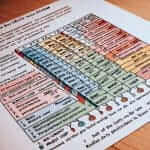As an IELTS instructor with over 20 years of experience, I’ve encountered countless students who find the IELTS Speaking section daunting. Many worry about being caught off guard by unexpected questions. While it’s impossible to predict every question, there are common themes and topics that frequently appear. One such topic is art, particularly the question: “What kind of art do you like?”
This seemingly simple question can actually be quite multifaceted. It tests not only your vocabulary related to art but also your ability to articulate your preferences, provide reasons, and engage in a conversation about a potentially subjective topic.
Understanding the Question’s Significance
The examiner isn’t just looking for a list of art forms you enjoy. They are assessing your ability to:
- Use a range of vocabulary: Demonstrate your knowledge of words related to art, such as “genre,” “medium,” “technique,” “composition,” “abstract,” “realistic,” and so on.
- Express preferences clearly: Clearly state your likes and dislikes and elaborate on the reasons behind them.
- Provide examples: Support your preferences with specific examples of artists, artworks, or experiences.
- Maintain a conversation: Respond fluently and coherently to follow-up questions.
Navigating the “What Kind of Art Do You Like?” Topic
Here’s a breakdown of how to effectively address this question:
1. Identify and Expand Upon Your Preferences
Don’t just say “I like paintings.” Be specific! Do you prefer classical art, Renaissance art, Impressionism, abstract art, or something else entirely? Consider different forms of art beyond painting, such as:
- Sculpture
- Photography
- Film
- Music
- Dance
- Architecture
- Literature
2. Articulate Your Reasons
Explain why you are drawn to certain types of art. Do you appreciate the technical skill involved, the emotions it evokes, the messages it conveys, or the cultural significance it holds? For instance:
- “I’m particularly drawn to Impressionist paintings because I find the way they capture light and atmosphere to be mesmerizing.”
- “I’ve always loved classical music, especially Mozart, for its complexity and the way it makes me feel.”
- “The intricate details and symbolism found in Renaissance sculptures never cease to amaze me.”
3. Provide Concrete Examples
Back up your preferences with examples. Mention specific artists, artworks, museums you’ve visited, or even personal experiences that have shaped your tastes.
- For example: “I recently visited the Musée d’Orsay in Paris, and I was blown away by the Impressionist collection, particularly Monet’s ‘Water Lilies.'”
 Impressionist Painting
Impressionist Painting
4. Be Prepared for Follow-Up Questions
The examiner might ask you to elaborate on your preferences, so be ready to discuss:
- Your favorite artists and artworks.
- What you find appealing or unappealing about certain styles.
- How your taste in art has evolved over time.
- Whether you create art yourself.
5. Practice Makes Perfect
Practice speaking about different types of art using the strategies outlined above. You can do this by:
- Having conversations with friends or fellow IELTS students.
- Recording yourself and analyzing your responses.
- Using IELTS practice materials and sample questions.
Example:
Examiner: “What kind of art do you like?”
Candidate: “Well, I’m particularly drawn to abstract art. I find it fascinating how artists can use colors, shapes, and textures to evoke such powerful emotions and ideas without depicting anything realistically. For example, I’m a big admirer of Wassily Kandinsky’s work. His paintings are so vibrant and full of movement, and they really speak to me on an emotional level.”
Conclusion:
Remember, the key to success in the IELTS Speaking test is to demonstrate your language skills effectively. By preparing thoughtfully, using a wide range of vocabulary, and expressing yourself clearly and confidently, you’ll be well-equipped to handle any questions about your artistic preferences.


